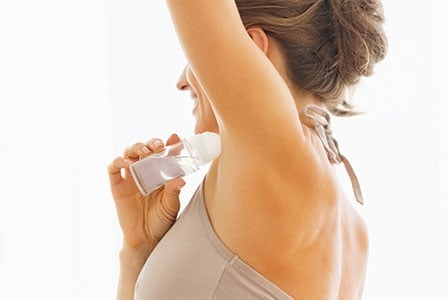
Conventional antiperspirants contain some dangerous chemicals. Natural options are safer, effective, and widely available.
Whether it’s the first day back at school, a big presentation at work, or a tough workout, we’ve all experienced sweat—and the embarrassing body odour that can go with it. While conventional deodorants and antiperspirants contain some dangerous and questionable chemicals, there are plenty of natural options that are safer, effective, and widely available.
What is sweat?
Sweat is mostly made up of water, with some other components such as salt, sugar, and our bodies’ byproducts, urea and ammonia.
Although it certainly has a bad reputation, there’s nothing wrong with sweat. It actually does some amazing things for us. Its roles include
- regulating temperature by helping us cool down
- helping our bodies heal wounds
- excreting certain toxins, such as phthalates, arsenic, cadmium, lead, and mercury
Sweat doesn’t actually smell bad at all! It’s only when sweat mixes with bacteria on the skin that it smells. Knowing all of this about sweat brings up questions about whether or not preventing sweat with antiperspirants (rather than just covering or neutralizing odour with deodorants) is indeed a good idea.
Something smells fishy
Nope, not body odour—it’s the many questionable chemicals in conventional deodorants. Here are a few common culprits.
Aluminum
Aluminum is a common, well-known active ingredient in many conventional antiperspirants. It works by temporarily plugging sweat ducts, so sweat is less likely to reach the surface of the skin.
This controversial chemical is best avoided because it has been accused of causing breast cancer. Although the National Cancer Institute states that it is not aware of any conclusive evidence that links the use of aluminum-based antiperspirants to an increase in breast cancer, it does agree that more research is needed.
Triclosan and/or triclocarban
While aluminum is a very well-known ingredient, triclosan and triclocarban are relatively new in antiperspirants and deodorants—and relatively unknown by consumers.
Triclosan and its chemical cousin triclocarban are antibacterial compounds. Triclosan was actually first registered as a pesticide in 1969 before making its way into common household goods such as antibacterial soap and deodorants.
One of the concerns about this terrible twosome is its potential to encourage bacterial resistance to antibiotics. According to the Environmental Working Group, triclosan has been linked to liver and inhalation toxicity, and might be harmful to thyroid function. It’s also known that triclosan and triclocarban are toxic to aquatic life and persist in the environment, so it’s best avoided by both the health- and eco-conscious.
Fragrance/parfum
Fragrance or parfum can refer to a secret mixture of any number of compounds. In natural products, they are often naturally derived from sources such as essential oils. However, fragrance in many conventional products can contain potentially hazardous chemicals. Furthermore, the mixture can also include parabens or phthalates, two types of preservatives that can act as hormone disruptors and may be linked to cancer.
When choosing natural deodorants, look for the words “paraben-free” and “phthalate-free” on the label, make sure the added fragrance is derived from essential oils (labels often specify), or choose unscented versions.
Natural options
A plethora of natural options exist at natural health retailers everywhere, and the diversity of choices may be surprising. As with most products, you may have to try out a few different formats, scents, or brands to determine which you like best. Check with store staff, ask questions about the different choices, and try them out!
These are a few common types of natural deodorants.
Natural stick deodorants
What they are: Stick deodorants are likely the most familiar form of deodorant, so they might be the easiest way to make the transition to natural. Ingredients might include zinc, coconut or other plant oils, and soothing aloe vera.
The how-to: Use most natural stick deodorants the same way you’d use conventional forms—swipe in the armpit daily after washing.
Liquids
What they are: People who might not like the texture of stick deodorants might prefer refreshing-feeling liquid deodorants. Common ingredients include witch hazel and odour-fighting botanicals such as tea tree oil, citrus, or sage.
The how-to: Liquid deodorants are applied daily and available in roll-on bottles or spray bottles.
Powders
What they are: Deodorant powders are a unique option that commonly contains cornstarch or baking soda to neutralize odours. Avoid those made with talc, which can be dangerous if inhaled and may contain naturally occurring asbestos.
The how-to: Apply by tapping the deodorant onto fingers or underarms and massaging it into skin with your fingertips.
Creams
What they are: While they seem like a strange option at first, deodorant creams are a cult favourite. Common ingredients include zinc, vegetable oils, baking soda, cornstarch, clay, and shea butter.
The how-to: Deodorant creams are generally applied with the fingers. Some versions are meant to be applied every day, while others can be applied every few days—check the label to be sure.
Crystal stones
What they are: Lesser-known deodorant stones are also a beloved choice for many. They look like crystals (hence their nickname), are made from odour-eliminating mineral salts, and are typically fragrance-free.
The how-to: Crystal deodorant stones are wetted and applied to skin. They often come with a small dish—similar to a soap dish—to store them.
A brief history of sweat
Although—assumedly—body odour has been around for quite some time, humans only started using antiperspirants relatively recently. Rumour has it the first antiperspirants and deodorants were invented and trademarked in the late 19th and early 20th century. Before then, people dealt with body odour by bathing, using perfume, and using dress shields—pads placed in the armpits that protected clothing from sweat.
Resources
These fantastic environmental and health organizations can help you learn more about chemicals in conventional deodorants and antiperspirants, and help you make safer choices.
- Campaign for Safe Cosmetics safecosmetics.org
- David Suzuki Foundation davidsuzuki.org
- Environmental Defence environmentaldefence.ca and justbeautiful.ca
- Environmental Working Group’s Skin Deep cosmetics database ewg.org/skindeep


